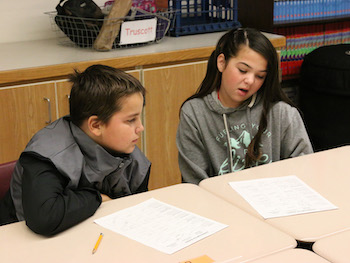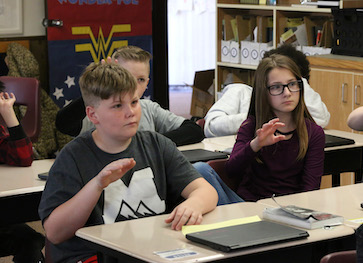SUBJECTS
GRADE
Show Results
Revolutionary Tea

Lesson Summary
- Sing and conduct the song "Revolutionary Tea."
- Discover allegorical meaning in the lyrics connecting to the Boston Tea Party.
Lesson Plan and Procedure
Lesson Key Facts
- Grade(s): 5
- Subject(s): English Language Arts, Music, Social Studies
- Duration of lesson: 45 minutes
- Author(s): Susan Kenney
Vocabulary
allegory, three-pence, conveyed, quoth, meter, Great Britain, King George II
Background Information
The American colonists felt that the British, under the leadership of King George II, were taxing the colonies unfairly. So, on December 16, 1773, 60 men (led by Sam Adams) dressed like Mohawk Indians, boarded three British ships delivering tea in the Boston Harbor, and dumped 342 boxes of tea into the ocean. This event became known as the Boston Tea Party and further strained relations between the colonists and the British parliament. Not long after, Thomas Jefferson, with other protestors, wrote the Declaration of Independence, leading to the American Revolution.
“Revolutionary Tea”—An Allegory
Discuss the story of the Boston Tea Party.
Teacher: The song “Revolutionary Tea” is about the Boston Tea Party. It is an allegory—a story that is about one thing but really means something else. An allegory is kind of a puzzle, or a secret code that only certain people will understand. This song is about an old lady and her daughter. But they do not represent people. Can you figure out what the old lady and the daughter represent, as you listen to this song story?
Sing verse one. Discuss the old lady representing Great Britain and the daughter meaning the 13 colonies.
 Teacher: What gave you clues? (The ocean of water between them, island, new country, etc.) I sang just part of the story. Now listen as I sing the whole story to see if you notice any other words or phrases that have hidden meaning.
Teacher: What gave you clues? (The ocean of water between them, island, new country, etc.) I sang just part of the story. Now listen as I sing the whole story to see if you notice any other words or phrases that have hidden meaning.
Sing the entire song as learners listen.
Pass out the “Revolutionary Tea” allegory worksheet, and invite the learners to listen to the song again and answer the questions. Sing the entire song.
Allow the learners to work in groups to finalize their answers. Then discuss.
Answers appear here:
- Old ladies’ pockets were the British government holdings, coffers.
- The colonies were expected to pay taxes.
- The tea was brought on a ship.
- The daughter’s door was the Boston Harbor.
- The bouncing girl represents the 60 men, dressed as Mohawk Indians, who dumped the boxes of tea in the harbor.
Teacher: In order to drink tea, it must be steeped in water. What are the implications or conclusions that can be drawn from the statement?
Sing the song again. Now that the allegory is a little clearer, invite learners to sing the repeated line at the end of each verse.
 Teacher: The repeated-last-phrase form was often used when folks made up songs. The person singing would make up a verse, and the whole group would repeat the last line.
Teacher: The repeated-last-phrase form was often used when folks made up songs. The person singing would make up a verse, and the whole group would repeat the last line.
Invite the learners to bounce-conduct as they attempt to sing parts of the song with you. Notice places where they have trouble remembering the words or tune
Repeat singing and conducting, but this time show the music score, so they can read as they sing and conduct (multi-tasking big time).
Extensions
- Discuss the idea that when our country was just beginning, people used to get together and make up songs about what was happening in their lives. “Revolutionary Tea” is one of those songs. Ask students if they made up a song, what it would be about. Discuss the students ideas for their songs. If appropriate, put learners in groups and see what they come up with. They might use the same tune as “Revolutionary Tea,” but with their own words.
- Create a play about the Boston Tea Party. Determine what actors you would need and what scenery to use. Use the song to tell part of the story. Include a chorus to sing the narration and soloists to sing the parts of the mother and daughter.
- Invite children to make pictures for each verse; then create a slideshow to use when singing.
Learnings for Students to Take Away
- When I listen, I can discover the beat and meter of this song
- I know another song about American history.
- I can sing.
- I know what an allegory is.
- I know that people in the past composed songs about their lives, and I can do that, too.
- I know the following vocabulary words/ideas: allegory, three-pence, conveyed, quoth, tag, phrase.
Music Ideas Experienced
- Music may have a steady beat.
- Beats may be organized into patterns of strong/weak, creating a meter of two.
- Music is organized into patterns called phrases.
- Opera is a play that is sung.
Other possible subject integrations
Patterns—math
Drama, creative play
Imagination
Learning Objectives
- Deepen understanding of the Boston Tea Party.
- Explore historical events through song lyrics.
- Describe imagery conveyed through allegorical lyrics.
- Explain how a series of stanzas fit together to provide the overall structure of a story told through song (ballad).
- Demonstrate understanding of figurative language found in an allegory.
Utah State Board of Education Standards
This lesson can be used to meet standards in many grades and subject areas. We will highlight one grade’s standards to give an example of application.
Grade 5 Social Studies
- Standard 5.2.1: Use primary sources to craft an argument representing different perspectives during the period leading to the American Revolution (for example, men and women who were Loyalists, Patriots, Native Americans, enslaved people).
- Standard 5.2.3: Explain how the actions of key individuals and groups influenced the outcome of the American Revolution (for example, George Washington, Thomas Jefferson, Thomas Paine, Benjamin Franklin, Mercy Warren, Alexander Hamilton, King George III, Haudenosaunee (Iroquois) Confederacy, Marquis De Lafayette, Phillis Wheatley).
Grade 5 Music
- Standard 5.M.P.4: Sing folk, traditional, and rounds in tune, with good vocal tone and clear diction.
- Standard 5.M.P.7: Perform and identify rhythm patterns in two-, three-, and four-beat meters using body percussion, voice, and simple instruments.
- Standard 5.M.R.2: Listen for and identify form, meter, rhythm, timbre, mood, tempo, melody, texture, and harmony/tonality.
- Standard 5.M.R.4: Describe feelings or imagery conveyed by a music selection.
- Standard 5.M.CO.3: Deepen understanding of another content area through music.
- Standard 5.M.CO.4: Experience and explore music which connects us to history, culture, heritage, and community.
- Standard 5.M.CO.5: Identify connections between a music genre and cultural or historical contexts.
Grade 5 English Language Arts
- Standard 5.R.8: Determine the meaning of figurative language and analyze their effect on meaning within a text. (RL)
- Standard 5.R.10: Analyze how a series of chapters, scenes, or stanzas fits together to provide the overall structure of a literary text. (RL)
Equipment and Materials Needed
- Slides 9-11 in PowerPoint: “Folk Songs from U.S. History”
- Pictures of the Boston Tea Party (online)
- PDF of “Revolutionary Tea” sheet music and chord chart
- PDF of “Revolutionary Tea” allegory worksheet
Additional Resources
This lesson is a part of a series of lessons about folk songs from United States History. Other lessons in the series include the following:
- “Follow the Drinking Gourd”
- “Froggie Went a-Courtin’”
- “John Henry”
- “Our National Anthem: A 'Whole Language' Experience”
Image References
Image 1: W.D. Cooper. "Boston Tea Party." The History of North America. London: E. Newbury, 1789.
Image 2–3: James Huston.

www.education.byu.edu/arts/lessons
 Download
Download